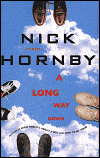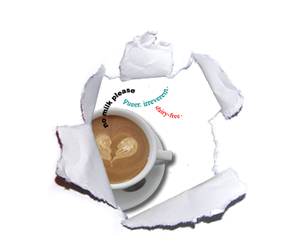 There are a lot of ways to commit suicide: jumping off a bridge, ODing on drugs, pissing off Oprah; but I’ve never really seriously considered it. I mean, yes, as with many alienated gay teens, I have fantasized about Ending It All instead of having to suffer one more day of wearing a uniform to high school.
There are a lot of ways to commit suicide: jumping off a bridge, ODing on drugs, pissing off Oprah; but I’ve never really seriously considered it. I mean, yes, as with many alienated gay teens, I have fantasized about Ending It All instead of having to suffer one more day of wearing a uniform to high school. But in my fantasies, I’ve somehow skipped the killing myself part and pictured myself lying in the casket, looking serene and peaceful, a light dusting of powder on my nose and cheeks to prevent shine. My family would be wailing, beating on their chests. Serves them right for not letting me go to the Salsa and Merengue Dance Camp.
Suicide is scary to me. Death is scary to me. I fear death because I fear the pain of dying. I visualize the dying, I visualize the pain.
I have very lurid visions of what it would be like to be rammed head-on by a speeding semi-truck while driving on a highway.* I look at a knife and imagine someone stabbing me repeatedly, my eyes watching the blood spurt from my chest, a silent scream frozen in my mouth. I think about suffocating under Star Jones and an avalanche of Payless shoes.
But what of those who experience a pain in life that exceeds that of the pain of dying? At least when you’re dead, there is no more pain. In life, you must continue to suffer. In life, you must continue to deal with loss, abandonment and rejection and then you have to walk eight blocks home in stiletto heels, two sizes too small.
And I don’t want to belittle the struggles of our gay youth, many of whom thoughts of suicide are not a fantasy, but a very real struggle. Even for gay kids with very understanding and supportive parents, the dangers of suicide and depression lurk. Some statistics may indicate that gay people, especially teens, are more likely to commit suicide than their straight counterparts.
I will not paint us queers as victims or martyrs, despite its possibilities for a one-man-cabaret show. But we must be vigilant. We must protect ourselves, protect our children, and we must charge a two-drink minimum.
It seems ironic to me that the only kind of control suicides have on their lives is the manner of their deaths. But sometimes, even that is foiled. Of almost a third of people who fully intend to kill themselves, fewer than half succeed. Those that fail generally do so because of unexpected rescue, or, more often, mistakes in planning or knowledge.

 In a way, that’s what happens in Nick Hornby’s new novel A Long Way Down. Hornby conjures a story of four very different people, in very different times of their lives, who happen to meet one New Year’s Eve at the top of the fictional Topper’s House, a London building with the reputation of being a suicide’s destination. It is this chance meeting that stops the four from going through with their plans.
In a way, that’s what happens in Nick Hornby’s new novel A Long Way Down. Hornby conjures a story of four very different people, in very different times of their lives, who happen to meet one New Year’s Eve at the top of the fictional Topper’s House, a London building with the reputation of being a suicide’s destination. It is this chance meeting that stops the four from going through with their plans. There is forty-something Martin, disgraced morning talk show host, ex-con, who had gone to jail for having sex with a minor; Maureen, middle-aged single mother, with a vegetable for a son and I don’t mean a turnip; Jess, eighteen, heartbroken, who wonders why her ex-boyfriend won’t explain to her why they broke up; and JJ, American, wanna-be rock star, condemned to a life of delivering pizza.
Except for Martin, I thought about how flimsy some of the others’ reasons were for ending their lives. But Hornby’s ear for dialogue, his talent for moving the story forward, enabled me to get over the initial skepticism and get into the story.
As it turns out, things run much deeper. As we get to know the characters and their lives, we find that there are many incidents that propelled these people towards that fateful New Year’s Eve. It was as if events have aligned in such a manner that led them down this path.
I am reminded of an article from The New Yorker which told about a guy in his thirties, who wrote a suicide note and left it on his bureau. It said, ‘I’m going to walk to the Golden Gate Bridge. If one person smiles at me on the way, I will not jump.’
He jumped off the bridge.
In A Long Way Down, the meeting of the four was an equivalent of that smile. It was the stay of execution, so to speak. They make a pact to get back together at the same place on Valentine’s Day to see if they are still in the same place. Then, because of Martin’s fame as an ex-talk show host, the tabloids got a hold of their story and their lives become entangled.
I had to assume that these people were really serious about committing suicide otherwise the story would sorta fall apart. I’m not sure Nick Hornby really convinced me because the characters are so chatty, so full of life that it’s hard to imagine them offing themselves. But then again, I’ve read about people who seemed to have everything going for them, go off and kill themselves, leaving friends and relatives mystified on what had happened.
Three of the four are proto-Hornby characters: Martin, Jess and JJ are charmingly verbose, introspective and full of cultural references. However, it is middle-aged Maureen whom I identified with the most. She compares life to a television program about a Scottish detective who had family problems:
“In an hour-long program, there was probably ten minutes of him arguing with his ex-wide and his children, and fifty minutes of him trying to find [the murderer]. That’s about right to me, ten minutes an hour [dealing with problems]. But there have been lots of times when I couldn’t stop [my son] from becoming sixty minutes an hour, and when you do that, you’re bound to end up on the roof of Topper’s House.”
I really enjoyed the novel. It is a quick read, a slim volume. It’s better than How To Be Good, though not to the level of About A Boy or High Fidelity.

I do have a very personal experience with suicide. Late one winter night, while I was driving home from a movie, I had received a tearful phone call from my friend Susannah. She was crying inconsolably, gasping out every word. She could not take a breath, there was so much grief pouring out of her. I tried to calm her down for a nearly an hour, listening and comforting.
Then suddenly, she was quiet. She had finally calmed down, I thought. After a minute of silence, she said, “Thank you, Paul. Goodbye.”
As I got ready for bed, I couldn’t shake the bad feeling I had. I put on my pants and drove to Susannah’s apartment and knocked loudly at her door, calling out her name. I didn’t care about waking the neighbors even though it was past midnight.
I couldn’t hear anything. I don’t know how long I knocked. It couldn’t have been too long, but it felt like ages.
Susannah opened the door. I was relieved. The apartment was completely dark when I entered. I went from room to room, turning on lights. I didn’t know what I was looking for. A gun. Pills. A toilet plunger. I don’t know.
 When I got to the kitchen, I found all the windows were shut and the cracks under the doors were sealed with towels. The oven was turned on, its door lying open. On the floor in front of it, I found a blanket and a tear-soaked pillow.
When I got to the kitchen, I found all the windows were shut and the cracks under the doors were sealed with towels. The oven was turned on, its door lying open. On the floor in front of it, I found a blanket and a tear-soaked pillow. In the novel, Martin realizes a very important truth about suicide: "Failure is as hurtful as success, and is likely to provoke even more anger, because there’s no grief with which to water it down."
I was never angry at Susannah. I was angry my helplessness. I was angry at my fear. I was angry at the world. But I wasn’t angry at her.
There have been thousands of suicides at the Golden Gate Bridge, but only twenty-six have survived the jump. One survivor, Ken Baldwin, recalls what he thought a few seconds after he jumped: “I instantly realized that everything in my life that I’d thought was unfixable was totally fixable--except for having just jumped.”
I visited Golden Gate Bridge late last year. I remember looking down the bridge, my heart in my throat. The water looked very beautiful, very blue. It didn’t look like it was a long way down. Not at all.
 Read what She said.
Read what She said. Back to Main Site
Back to Main Site
-----
* I wrote this post before I learned of Doug's death. I couldn't help but think of what it might've been like to be in the car he was in, to be sitting in the car when that girl hit them from behind...
"Jumpers" by Tad Friend. The fatal grandeur of the Golden Gate Bridge.
Tad Friend discusses his New Yorker article on NPR (audio)
CDC: Suicide Fact Sheet
Suicide facts
Teen suicide facts
 My Bookshelf
My BookshelfRecommended books by Nick Hornby:





No comments:
Post a Comment